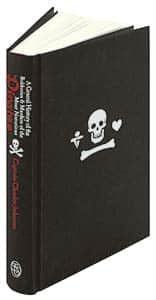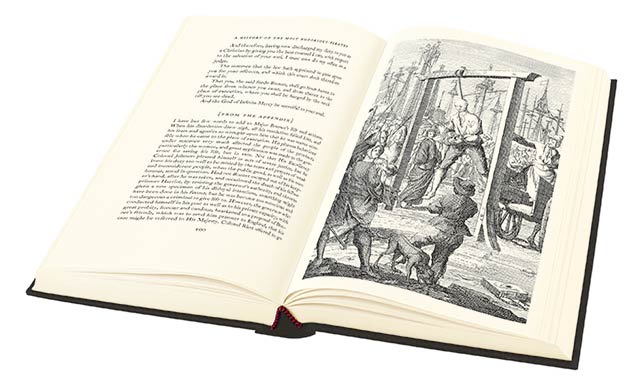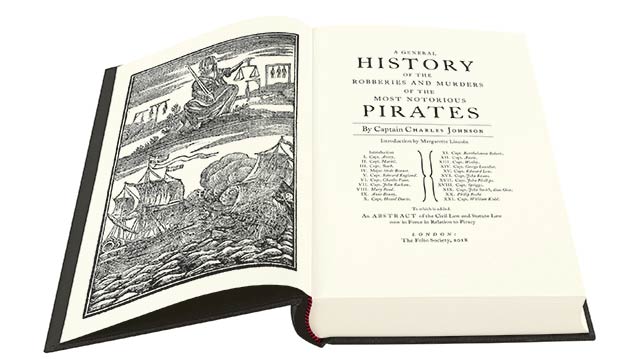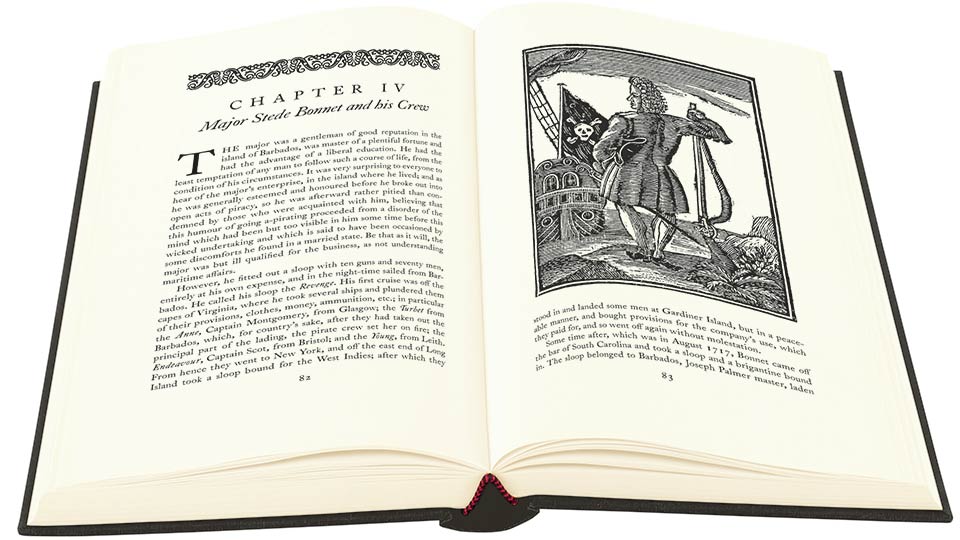
The Folio Society has released Captain Charles Johnson’s A General History of the Robberies & Murders of the Most Notorious Pirates. The title was first published as a two-volume edition in 1728 when it cashed in (yes, publishing houses knew how to make the most of a bestseller even in those days) on its earlier smash-hit single edition that graced the bookcases of even the best and most refined families.
The tales of derring-do, buccaneering and grand theft on the high seas contained within this volume sparked imaginations and set many pirating tropes that remain in circulation amongst six year-olds today. From the Jolly Roger skull and crossbones flag that appears in an illustration in the chapter on Major Stede Bonnet and is described in detail in the chapter on Captain Spriggs, to the buried treasure, naval battles in far-flung corners of the empire and ignominious executions, A General History of the Robberies & Murders of the Most Notorious Pirates is the first book that brought together British pirate folklore and turned it into a mythology that still influences how we think about pirates. Even in an age where even technological sophistication cannot yet render trading ships safe from the treat of seafaring robbers in some remote and less well-policed waters, there is a romanticism attached to pirates, as there is to all nomadic (and therefore usually parasitic) lifestyles. Perhaps we all possess an ancestral yearning for greater freedom and more excitement? For readers of the time, the volume would have had the thrills and spills of a James Bond novel, with exotic locations including the Americas, Africa and the Caribbean.
The book, a long account of miscreants and ne’erdowells, was hugely popular with the reading public, though the sensationalist aspects would have meant that women were perhaps advised not to stray too far from their fainting couches, and it also resonated with high-profile writers including Robert Louis Stevenson, whose best-known title Treasure Island pays homage. Israel Hands, a member of Long John Silver’s crew, is mentioned here amongst Blackbeard’s crew, and there’s also a Captain “Hawkins”, a victim of Captain Spriggs, who may well have given his name to Jim Hawkins, Louis Stevenson’s juvenile hero. So if the book was so influential, why isn’t the author a familiar household name?
The introduction tells us that efforts to find the identity of the author have never proven fruitful, and that it’s almost certainly a pseudonym. It’s a shame, because Captain Charles Johnson (who provides the introduction) sounds a fascinating character in his own right. There’s said to be a credible rumour that Daniel Defoe wrote the accounts, though this reviewer is sceptical – these stories lack the literary flair and pace for storytelling that the author of Robinson Crusoe had in abundance.

So what can we make of the title today? Each chapter concentrates on one pirate, sometimes with sketched descriptions of members of his crew, and some are better known than others. Almost everyone has heard of Henry Avery and Blackbeard (real name Edward Teach), who make up the opening two chapters. For a touch of gender equality, there are short but unforgettable segments on Mary Read and Anne Bonny, with a strong subtext suggesting a romantic involvement between the two, though despite this brief Sapphic diversion, the stories are overwhelmingly male-dominated, as one might expect from the pirating culture of the age.
Having read the book, the title ends up feeling slightly hyperbolic, because although the criminal deeds of the subjects makes up much of the word count, there is probably an equal focus on bringing them to justice, where their fates usually involve a valiant death in combat or public execution. There is little hint that the book is a work of scholarly endeavour. In a later account of an appearance in court of a member of Captain Thomas Anstis’ crew, the author comments, “This is the trial just as it was related to me,” which is a shorthand way of saying his version of events is heavily if not wholly fictionalised – there is no use of actual court records, though the trial of Major Stede Bonnet is told at much greater length. Some pirates, such as Bartholomew Roberts, have their stories told at length. Others are rattled through with scant regard for the fleshing out of details.

Contemporary readers may find this an enjoyable collection of interlinked yarns, where characters pop up in different chapters – Thomas Anstis, for example, had taken the ship of Captain John Phillips, who receives his own focus. They are likely to enjoy the fantastical elements of the storytelling. In a world where younger persons of a more sensitive disposition find the American situation comedy Friends unacceptably politically incorrect, it’s worth also commenting that the author’s worldview is a product of its time, and that slavery was still a legal and lucrative business when he was writing, and that some races were treated as subhuman. Taken as a whole, the collection of stories start to become repetitive, in structure and content, beginning with place of birth, sketching in pirating activities and ending on their fates.
The book is beautifully presented by the Folio Society, and a great detail is that it is set in the Caslon font that is a hallmark of 17th Century printing. The sense of authenticity is increased by retaining 35 woodcut illustrations which often bring to life the anti-heroes of the pages, and their fearsome exploits. If all things a-pirating sets your imagination racing, A General History of the Robberies & Murders of the Most Notorious Pirates will certainly prove a treasure trove.
The Folio Society edition of A General History of the Robberies & Murders of the Most Notorious Pirates by Captain Charles Johnson, introduced by Margarette Lincoln is available exclusively from The Folio Society.
Publisher: The Folio Society Publication date: Available now


